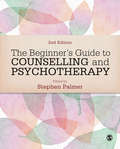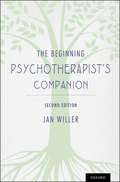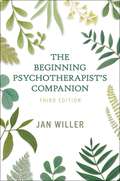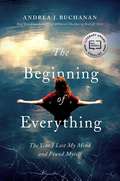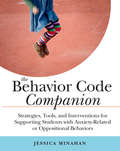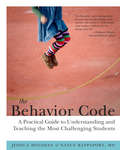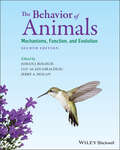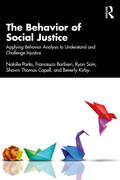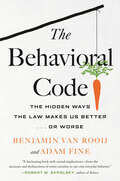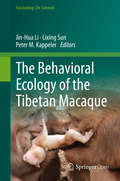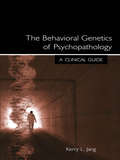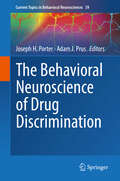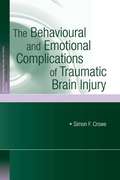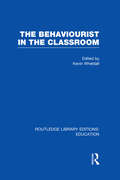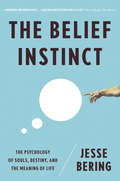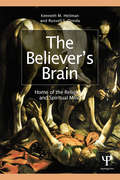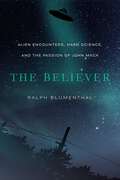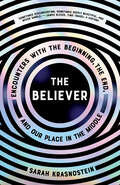- Table View
- List View
The Beginner's Guide to Counselling & Psychotherapy
by Professor Stephen PalmerAre you interested in the field of counselling and psychotherapy or just starting out in your training? Trying to get to grips with the many different approaches and decide which are right for you? This book can help! An ideal introductory text that assumes no prior knowledge, leading authors in the field provide overviews of 26 counselling and psychotherapy approaches in accessible, jargon-free terms. Each approach is discussed using the same framework to enable easy comparison and evaluation, covering: · Development of the Therapy · Theory and Basic Concepts · Practice · Which Clients Benefit Most? · Case study Four further chapters offer an insight into the therapeutic relationship, working with diversity, professional issues, and research, while resources such as suggested reading, discussion issues, appendices of further information and a comprehensive glossary help you consolidate your learning. So look no further if you want to know the differences between counselling and psychotherapy, compare psychodynamic and psychoanalytic theories, discover how constructivist approaches can be applied in practice, learn about third wave CBT therapies, or just get an general overview of the field; this second edition of a bestseller gives you a whirlwind tour of the breadth, complexity, fascination and problems of the field of counselling and psychotherapy.
The Beginner's Guide to Counselling & Psychotherapy
by Stephen PalmerAre you interested in the field of counselling and psychotherapy or just starting out in your training? Trying to get to grips with the many different approaches and decide which are right for you? This book can help! An ideal introductory text that assumes no prior knowledge, leading authors in the field provide overviews of 26 counselling and psychotherapy approaches in accessible, jargon-free terms. Each approach is discussed using the same framework to enable easy comparison and evaluation, covering: · Development of the Therapy · Theory and Basic Concepts · Practice · Which Clients Benefit Most? · Case study Four further chapters offer an insight into the therapeutic relationship, working with diversity, professional issues, and research, while resources such as suggested reading, discussion issues, appendices of further information and a comprehensive glossary help you consolidate your learning. So look no further if you want to know the differences between counselling and psychotherapy, compare psychodynamic and psychoanalytic theories, discover how constructivist approaches can be applied in practice, learn about third wave CBT therapies, or just get an general overview of the field; this second edition of a bestseller gives you a whirlwind tour of the breadth, complexity, fascination and problems of the field of counselling and psychotherapy.
The Beginning Psychotherapists Companion
by Jan WillerThe reader is guided on how and when to refer clients for medication and other health care. Crisis management principles are detailed, including suicide and violence risk assessment, child abuse, elder abuse, intimate partner violence, and rape. Willer also provides professional advice on contemporary concerns such as social networking, online searches of clients, the psychotherapist's internet presence, and other important emerging challenges.
The Beginning Psychotherapist’s Companion
by Jan WillerWith a reassuring and clear writing style, this third edition of The Beginning Psychotherapist's Companion offers practical suggestions and clinical examples to address the professional development and emotional concerns of the beginning psychotherapist. Guidance is provided on managing readers' relationships with their supervisors and diverse clients; the book also educates readers on managing their personal well-being, and discusses the foundations of ethical practice, including informed consent, confidentiality, and documentation. Extensive coverage of boundary issues includes self-disclosure and the reader's online presence. The reader also is guided on how and when to refer clients for medication and other types of healthcare. Willer also provides professional advice on contemporary concerns such as telehealth, social networking, online searches of clients, the psychotherapist's internet presence, electronic communications and data management, and other important emerging challenges. Approaches to behavioral health emergencies are introduced. Comprehensive, practical, and thoroughly updated, The Beginning Psychotherapist's Companion continues to serve as the ideal resource for students and early career psychotherapists.
The Beginning of Everything: The Year I Lost My Mind And Found Myself
by Andrea J. BuchananA real-life neurological mystery?and captivating story of reinvention by the New York Times bestselling author of The Daring Book for Girls. Andrea Buchanan lost her mind while crossing the street one blustery March morning. The cold winter air triggered a coughing fit, and she began to choke. She was choking on a lot that day. A sick son. A pending divorce. The guilt of failing as a partner and as a mother. When the coughing finally stopped, she thought it was over. She could not have been more wrong. When she coughed that morning, a small tear ripped through her dura mater, the membrane covering the brain and spinal cord. But she didn’t know that yet. Instead, Andrea went on with her day, unaware that her cerebrospinal fluid was already beginning to leak out of that tiny opening. What followed was nine months of pain and confusion as her brain, no longer cushioned by a healthy waterbed of fluid, sank in her skull. At a time in her life when she needed to be as clear-thinking as possible?as a writer, as a mother, as a woman attempting to strike out on her own after two decades of marriage?she was plagued by cognitive impairment and constant pain, trapped by her own brain—all while mystifying doctors and pushing the limits of medical understanding. In this luminous and moving narrative, Andrea reveals the astonishing story of this tumultuous year—her fraught search for treatment; how patients, especially women, fight to be seen as reliable narrators of their own experiences; and how her life-altering recovery process affected both her and her family. The mind-brain connection is one of the greatest mysteries of the human condition. In some folklore, the cerebrospinal fluid around the brain is thought to be the place where consciousness actually begins. Here, in the pages of The Beginning of Everything, Andrea seeks to understand: Where was “I” when I wasn’t there?
The Behavior Code Companion: Strategies, Tools, and Interventions for Supporting Students with Anxiety-Related and Oppositional Behaviors
by Jessica MinahanSince its publication in 2012, The Behavior Code: A Practical Guide to Understanding and Teaching the Most Challenging Students has helped countless classroom teachers, special educators, and others implement an effective, new approach to teaching focused on skill-building, practical interventions, and purposeful, positive interactions with students who have mental health disorders. Based on the success of the previous book, author Jessica Minahan has written this companion guide for educators seeking additional guidance for creating and implementing successful behavior intervention plans ("FAIR Plans") for the students teachers worry about the most: those with anxiety-related or oppositional behaviors. Minahan takes readers step-by-step through the process of understanding and practicing the components of a FAIR behavior intervention plan so that they or a team can immediately customize it and put it to work in classrooms. Additional tips on creating interventions, as well as checklists to help with implementation and monitoring progress, are also included. Packed with brainstorming and reflection exercises, planning activities, templates, case studies, recommended apps, and other technology resources, The Behavior Code Companion will help educators create optimal classroom environments for all students.
The Behavior Code Companion: Strategies, Tools, and Interventions for Supporting Students with Anxiety-Related or Oppositional Behaviors
by Jessica MinahanSince its publication in 2012, The Behavior Code: A Practical Guide to Understanding and Teaching the Most Challenging Students has helped countless classroom teachers, special educators, and others implement an effective, new approach to teaching focused on skill-building, practical interventions, and purposeful, positive interactions with students who have mental health disorders. Based on the success of the previous book, author Jessica Minahan has written this companion guide for educators seeking additional guidance for creating and implementing successful behavior intervention plans (&“FAIR Plans&”) for the students teachers worry about the most: those with anxiety-related or oppositional behaviors. Minahan takes readers step-by-step through the process of understanding and practicing the components of a FAIR behavior intervention plan so that they or a team can immediately customize it and put it to work in classrooms. Additional tips on creating interventions, as well as checklists to help with implementation and monitoring progress, are also included. Packed with brainstorming and reflection exercises, planning activities, templates, case studies, recommended apps, and other technology resources, The Behavior Code Companion will help educators create optimal classroom environments for all students.
The Behavior Code: A Practical Guide to Understanding and Teaching the Most Challenging Students
by Nancy Rappaport Jessica MinahanBased on a collaboration dating back nearly a decade, the authors--a behavioral analyst and a child psychiatrist--reveal their systematic approach for deciphering causes and patterns of difficult behaviors and how to match them with proven strategies for getting students back on track to learn.The Behavior Code includes user-friendly worksheets and other helpful resources.
The Behavior Code: A Practical Guide to Understanding and Teaching the Most Challenging Students
by Jessica Minahan Nancy Rappaport MDBased on a collaboration dating back nearly a decade, the authors—a behavioral analyst and a child psychiatrist—reveal their systematic approach for deciphering causes and patterns of difficult behaviors and how to match them with proven strategies for getting students back on track to learn.The Behavior Code includes user-friendly worksheets and other helpful resources.
The Behavior of Animals: Mechanisms, Function, and Evolution
by Luc-Alain Giraldeau Jerry A. Hogan Johan J. BolhuisThe Behavior of Animals An updated view of animal behavior studies, featuring global experts The Behavior of Animals, Second Edition provides a broad overview of the current state of animal behavior studies with contributions from international experts. This edition includes new chapters on hormones and behavior, individuality, and human evolution. All chapters have been thoroughly revised and updated, and are supported by color illustrations, informative callouts, and accessible presentation of technical information. Provides an introduction to the study of animal behavior Looks at an extensive scope of topics- from perception, motivation and emotion, biological rhythms, and animal learning to animal cognition, communication, mate choice, and individuality. Explores the evolution of animal behavior including a critical evaluation of the assumption that human beings can be studied as if they were any other animal species. Students will benefit from an updated textbook in which a variety of contributors provide their expertise and global perspective in specialized areas
The Behavior of Social Justice: Applying Behavior Analysis to Understand and Challenge Injustice
by Shawn Thomas Capell Natalie Parks Francesca Barbieri Ryan Sain Beverly KirbyThis seminal work utilizes the principles of applied behavior analysis (ABA) to understand people’s actions. It provides a framework for the study of social injustices that moves beyond just condemning others for their oppressive behaviors, outlining solutions that help work towards a more socially just society.Divided across three main sections, the book outlines the basic principles of applied behavior analysis, considers key tenets of social justice work, and examines how social justice work can be carried out on an individual and a wider institutional level. The first section focuses on the principles of behavior and how it expounds on the causes, reasons, and purposes behind one’s actions. The subsequent sections pay particular attention to how prejudice, stereotypes, and bias play out in society, and how prejudices and biases make us more likely to participate in social injustices. The third section provides a behavioral description of various -isms and discusses the difference between -isms and individual behaviors, before exploring common -isms. The book concludes with an analysis of the reasons behind their persistence, followed by solutions that can be embraced by people.Packed with case studies and reflective questions, The Behavior of Social Justice is an essential reading for students and scholars of behavioral sciences, psychology, sociology and education, as well as academics and researchers interested in the study of social justice.
The Behavioral Code: The Hidden Ways the Law Makes Us Better or Worse
by Benjamin van Rooij Adam FineFreakonomics for the law—the revolutionary behavioral science insights into how the law fails to reduce misbehavior. Why do some laws radically change behavior whereas others are consistently ignored and routinely broken? Why do we keep relying on harsh punishment against crime even though it continues to fail?Professors Benjamin van Rooij and Adam Fine present the first accessible analysis of behavioral jurisprudence, which will fundamentally alter how we understand the connection between law and human behavior. Drawing upon decades of research, the authors reveal the behavioral code: the root causes and hidden forces that drive human behavior and our responses to society&’s laws.The Behavioral Code offers a necessary and different approach to battling crime and injustice that is based in understanding the science of human misconduct—rather than relying on punishment to shape behavior. The book will show how this code affects all of us using illustrative examples like:· Park rangers in Arizona&’s Petrified Forest who worked with social psychologists to reduce theft—beginning by throwing out &“no stealing&” signs· German walls that &“pee back&” at public urinators· A $2.3 billion legal settlement against Pfizer that revealed how whistleblower protections fail to reduce corporate malfeasance· NYC subway ads that reduced manspreading· How Richmond, California, reduced gun violence by offering young firearm offenders $1,000 monthly rewards for good behaviorRevelatory and counterintuitive, The Behavioral Code catalyzes the conversation about how the law can effectively improve human conduct and respond to some of our most pressing issues today, from police misconduct to corporate malfeasance.
The Behavioral Ecology of the Tibetan Macaque (Fascinating Life Sciences)
by Peter M. Kappeler Jin-Hua Li Lixing SunThis open access book summarizes the multi-disciplinary results of one of China’s main primatological research projects on the endemic Tibetan macaque (Macaca thibetana), which had continued for over 30 years, but which had never been reported on systematically. Dedicated to this exceptional Old World monkey, this book makes the work of Chinese primatologists on the social behavior, cooperation, culture, cognition, group dynamics, and emerging technologies in primate research accessible to the international scientific community.One of the most impressive Asian monkeys, and the largest member of its genus, the Tibetan macaque deserves to be better known. This volume goes a long way towards bringing this species into the spotlight with many excellent behavioral analyses from the field. - Frans de Waal, Professor of Psychology, Emory University, USA.Macaques matter. To understand primate patterns and trends, and to gain important insight into humanity, we need to augment and expand our engagement with the most successful and widespread primate genus aside from Homo. This volume focuses on the Tibetan macaque, a fascinating species with much to tell us about social behavior, physiology, complexity and the macaque knack for interfacing with humans. This book is doubly important for primatology in that beyond containing core information on this macaque species, it also reflects an effective integrated collaboration between Chinese scholars and a range of international colleagues—exactly the type of collaborative engagement primatology needs. This volume is a critical contribution to a global primatology. - Agustín Fuentes, Professor of Anthropology, University of Notre Dame, USA. I have many fond memories of my association with Mt. Huangshan research beginning in 1983, when together with Professor Qishan Wang we established this site. It is such a beautiful place and I miss it. It is gratifying to see how far research has progressed since we began work there, becoming more internationalized and very much a collaborative endeavor under the long-term direction of Professor Jin-Hua Li and colleagues. This book highlights the increased interest in this species, representing a variety of disciplines ranging from macro aspects of behavior, cognition and sociality, to micro aspects of microbes, parasites and disease, authored by a group of renowned Chinese and international primatologists. I applaud their efforts and expect more interesting work to come from this site in the years ahead. - Kazuo Wada, Professor Emeritus, Kyoto University, Japan.
The Behavioral Genetics of Psychopathology: A Clinical Guide
by Kerry L. JangNew discoveries about the genetic underpinnings of many kinds of human experience are now continually being made. This book explores the impact of these discoveries on the ways in which the common mental disorders are best conceptualized and treated.Most people think of research in genetics as the search for genes. This is only one focus of effort, and even with the reliable identification of susceptibility genes, the clinical applications of their discovery, such as gene therapies and new drug development, are a long way off. For the present, the impact of genetic research on our understanding of mental illness is tied to our ability to estimate the effect of all genes by means of family, twin, and adoption studies. The results of these studies challenge some deeply cherished ideas and theories, and support others.Of course, the effect of genes is only half the equation. The role of experience, environment, and living conditions accounts for as much, often considerably more, of the variability in psychopathology. In this book, Kerry Jang attempts not to answer questions about what is "genetic" and what is not, but about what a knowledge of the relative influence of genes versus environment means at a psychological level of analysis--to show how it changes common assumptions about classification, etiology, diagnosis, and intervention.He first offers an overview of contemporary behavioral genetics, dispels common misconceptions, responds to the criticisms that have been leveled at this new field, and describes in basic terms how genetic and environmental effects are estimated and how susceptibility genes are pinpointed. He then points to new directions in which standard nosological systems are likely to evolve as new information about vulnerabilities and covariances emerges. Finally, he synthesizes and evaluates the consistency of the last decade's findings for the most common categories of psychopathology that have been studied by behavior geneticists: mood, personality, and anxiety disorders, substance abuse; and schizophrenia and the psychotic disorders.Clinicians and researchers alike need to understand the genetic influences on the feelings and behaviors they are seeking to change or study if they are to be effective in their work. The Behavioral Genetics of Psychopathology: A Clinical Guide empowers them with this understanding.
The Behavioral Neurology of Dementia
by Miller Bruce L. Boeve Bradley F.The Behavioral Neurology of Dementia is a comprehensive textbook that offers a unique and modern approach to the diagnosis and treatment of patients with dementing conditions in the twenty-first century. The coverage is broad, ranging from common conditions such as Alzheimer's disease, Parkinsonian disorders, vascular and frontotemporal dementia, to the more obscure such as Jakob-Creutzfeldt disease. Subtypes of mild cognitive impairment are presented and the early prodromes of neurodegenerative diseases are explored. Simple approaches to bedside mental status testing, differential diagnosis and treatment, genetic testing, interpreting neuropsychological testing and neuroimaging findings, and assessing rapidly progressive dementias, paraneoplastic syndromes, and disorders of white matter give guidance to both the novice and expert in dementia. The basic science of dementia is outlined in introductory chapters on animal models of dementia, dementia epidemiology and dementia neuropathology.
The Behavioral Neuroscience of Drug Discrimination (Current Topics in Behavioral Neurosciences #39)
by Joseph H. Porter Adam J. PrusThe goal for this volume is to provide an up-to-date review of the discriminative stimulus properties of major psychoactive drug classes with an emphasis on how this paradigm enhances our understanding of these drugs and how these findings translate from animals to humans. The drug discrimination paradigm applies to both drugs of abuse and drugs for treating mental illnesses, and research from these studies has provided immense translational value for learning about the mechanisms responsible for drug effects in humans.
The Behavioral Significance of Color (Psychology Library Editions: Comparative Psychology)
by Edward H. Burtt JRPrior to publication the study of animal coloration was plagued by fanciful speculations, post hoc explanations and untestable hypotheses. This title, originally published in 1979, draws together widely scattered research into the coloration of animals; formulates predictive hypotheses to account for color; documents the accuracy of many of these hypotheses; and suggests directions for future research. The book grew out of a symposium, The Behavioral Significance of Color at the 1977 meeting of the Animal Behavior Society, and presents evidence concerning patterns of coloration and their influence on animal behaviour and interaction Physical principles of radiation are discussed in Chapter 1, followed, in subsequent chapters, by an examination of the physiological functions of animal coloration (e.g. thermoregulation, hydroregulation, abrasion-resistance, extraretinal photoreception). Treatment of coloration that affects the animal’s visibility to other animals opens with a masterful overview of theories of color vision and its occurrence throughout the animal kingdom. Chapter 6 explores the role of color vision and fruit color in the selection of food by wild primates with comments on the coevolution of fruiting trees and their primate customers. Dr Jack P. Hailman addresses the elusive concept of conspicuousness. He summarizes a strategy for calculating conspicuous coloration based on measurements in natural habitats. Experiments, naturalistic observations and anecdotes of optical communication are exceedingly numerous. Chapters 8 and 9 review these data and suggest general principles of inter- and intraspecific optical communication. Each chapter is enhanced by the critical evaluations of Drs. C. Richard Tracy and W. J. Hamilton III. In closing, the editor discusses coloration as it affects an animal’s own vision (e.g., black eyelines to reduce glare). Most significantly the book emphasizes the need for a balanced, scientifically rigorous approach to the question of evolution of animal coloration. It is an important source for anyone contemplating or currently involved in research in this field of investigation.
The Behavioral and Cognitive Neurology of Stroke
by Olivier GodefroyThe care of stroke patients has changed dramatically in recent years. As well as improvements in the emergency care of the condition, there have been marked advances in our understanding, management and rehabilitation of residual deficits. This book is about the care of stroke patients focusing on behavioral and cognitive problems. It provides a comprehensive review of the field covering the diagnostic value of these conditions, in the acute and later phases, their requirements in terms of treatment and management, and the likelihood and significance of long-term disability. This book will appeal to all clinicians involved in the care of stroke patients, as well as to neuropsychologists, other rehabilitation therapists and research scientists investigating the underlying neuroscience.
The Behavioural and Emotional Complications of Traumatic Brain Injury (Studies On Neuropsychology, Neurology And Cognition Ser.)
by Simon F. CroweIt is difficult to imagine what it must be like for someone following the personal crisis and catastrophe that ensues as a result of a serious traumatic brain injury (TBI). The individual is confronted with a huge range of alterations in his or her normal functioning, operating at the biological, psychological and social levels. All of these c
The Behaviourally Informed Organization (Behaviourally Informed Organizations)
by Cass R. Sunstein Dilip Soman and Catherine Yeung, eds.Every organization is fundamentally in the business of behavior change. Whether it be a government trying to get business to comply with environmental regulation, a business trying to get its customers to be loyal to their products, or a financial advisor encouraging a client to start saving for retirement, behavior change is critical to organizational success. Despite its centrality to organizations, we do not have a good scientific framework for behavior change or a good understanding of how organizations can embed insights from behavioral science into their operations. To overcome this void, this book develops an overarching framework for using behavioral science. It shows how behavioral insights (BI) can be embedded in organizations to achieve better outcomes, improve the efficiency of processes, and maximize stakeholder engagement. This edited volume will provide an enterprise-wide strategic perspective of how governments, businesses, and other organizations have embedded BI into their operations. It is based on research by academics and practitioners from the Behaviourally Informed Organizations Partnership and will highlight ideas, pragmatic frameworks, and prescriptive outcomes, based on illustrative case studies. Featuring a foreword by Cass Sunstein, this book investigates key findings from BI, with an eye toward how it can be used to solve problems and seize opportunities in diverse organizations.
The Behaviourist in the Classroom (Routledge Library Editions: Education)
by Kevin WheldallIn the decade preceeding the original publication of this book the discipline of behaviour analysis was becoming increasingly influential in educational circles, but many of the practices we now take for granted were still being pioneered. This book considers the place of behaviour analysis in education and describes work on behavioural classroom management in British schools. Four further chapters consider the behavioural approach to teaching in both primary and secondary schools in terms of tutoring at home and for use with emotionally disturbed children. The book concludes with chapters on the role of theory in and an ethical appraisal of behavioural methods.
The Belief Instinct: The Psychology of Souls, Destiny, and the Meaning of Life
by Jesse BeringTop 25 Books of 2011 by the American Library Association, Choice Reviews Named one of the 11 Best Psychology Books of 2011 by The Atlantic "A balanced and considered approach to this often inflammatory topic." --Nature Lively and brilliantly argued, The Belief Instinct explains the psychology behind belief. Drawing on surprising new studies as well as on literature, philosophy, and even pop culture, The Belief Instinct will reward readers with an enlightened understanding of belief--as well as the tools to break free of it.
The Believer's Brain: Home of the Religious and Spiritual Mind
by Kenneth M. Heilman Russell S. DondaAbout 90% of people have faith in a supreme being, but our yearning for the divine, and whatever it promises, involves a large divergence in mental states and behaviors. Some adhere to doctrine, supplication, and fastidious religious practices; others have a strong sense they are part of something greater and more universal. However, all religious and spiritual paths are mediated by complex brain networks. When different areas of the brain are stimulated, a person can have a variety of experiences, but there is no specific ‘God spot’ where stimulation enhances religiosity or spirituality. Functional brain imaging shows that there are specific areas of the brain that ‘light up’ when subjects perform certain religious activities, but imaging only provides anatomic correlations, not functional explanations. The Believer's Brain takes a step beyond these singular methodologies, providing converging evidence from a variety study methods of how humans’ brain networks mediate different aspects of religious and spiritual beliefs, feelings, actions, and experiences. Although the book reveals how our brain is the home to the religious and spiritual mind, understanding this gift will not diminish our spirituality or our love or our belief in a supreme being, but will increase appreciation of the apparatus that mediates these mental states.
The Believer: Alien Encounters, Hard Science, and the Passion of John Mack
by Ralph BlumenthalThe Believer is the weird and chilling true story of Dr. John Mack. This eminent Harvard psychiatrist and Pulitzer Prize–winning biographer risked his career to investigate the phenomenon of human encounters with aliens and to give credibility to the stupefying tales shared by people who were utterly convinced they had happened.Nothing in Mack&’s four decades of psychiatry had prepared him for the otherworldly accounts of a cross section of humanity including young children who reported being taken against their wills by alien beings. Over the course of his career his interest in alien abduction grew from curiosity to wonder, ultimately developing into a limitless, unwavering passion.Based on exclusive access to Mack&’s archives, journals, and psychiatric notes and interviews with his family and closest associates, The Believer reveals the life and work of a man who explored the deepest of scientific conundrums and further leads us to the hidden dimensions and alternate realities that captivated Mack until the end of his life.
The Believer: Encounters with the Beginning, the End, and Our Place in the Middle
by Sarah Krasnostein“Deeply beautiful, and never simple.” — James Gleick, author of Time Travel: A History An unforgettable tour of the human condition that explores our universal need for belief to help us make sense of life, death, and everything in between. For Sarah Krasnostein it begins with a Mennonite choir on a subway platform, a fleeting moment of witness that sets her on a fascinating journey to discover why people need to believe in absolute truths and what happens when their beliefs crash into her own. Some of the people Krasnostein interviews believe in things many people do not: ghosts, UFOs, the literal creation of the universe in six days. Some believe in things most people would like to: dying with dignity and autonomy; facing up to our transgressions with truthfulness; living with integrity and compassion. By turns devastating and uplifting, and captured in snapshot-vivid detail, these six profiles — a death doula, a geologist who believes the world is six thousand years old, a lecturer in neurobiology who spends his weekends ghost hunting, the fiancé of a disappeared pilot and UFO enthusiasts, a woman incarcerated for killing her husband after suffering years of domestic violence, and Mennonite families in New York — will leave you convinced that the most ordinary-seeming people are often the most remarkable and that deep and abiding commonalities can be found within the greatest differences. Vivid, unconventional, entertaining, and full of wonder, The Believer interweaves these stories with compassion and empathy, culminating in an unforgettable tour of the human condition that cuts to the core of who we are as people, and what we’re doing on this earth.
